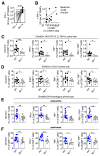MAIT cell activation augments adenovirus vector vaccine immunogenicity
- PMID: 33510029
- PMCID: PMC7610941
- DOI: 10.1126/science.aax8819
MAIT cell activation augments adenovirus vector vaccine immunogenicity
Abstract
Mucosal-associated invariant T (MAIT) cells are innate sensors of viruses and can augment early immune responses and contribute to protection. We hypothesized that MAIT cells may have inherent adjuvant activity in vaccine platforms that use replication-incompetent adenovirus vectors. In mice and humans, ChAdOx1 (chimpanzee adenovirus Ox1) immunization robustly activated MAIT cells. Activation required plasmacytoid dendritic cell (pDC)-derived interferon (IFN)-α and monocyte-derived interleukin-18. IFN-α-induced, monocyte-derived tumor necrosis factor was also identified as a key secondary signal. All three cytokines were required in vitro and in vivo. Activation of MAIT cells positively correlated with vaccine-induced T cell responses in human volunteers and MAIT cell-deficient mice displayed impaired CD8+ T cell responses to multiple vaccine-encoded antigens. Thus, MAIT cells contribute to the immunogenicity of adenovirus vectors, with implications for vaccine design.
Copyright © 2021 The Authors, some rights reserved; exclusive licensee American Association for the Advancement of Science. No claim to original U.S. Government Works.
Conflict of interest statement
C.D., C.S.R., and A.J.P. are named inventors on a patent application in the field of meningococcal vaccines. A.J.P. waives his rights under any patent. P.K. is a named inventor on a patent application in the field of cancer vaccines.
Figures




Comment in
-
Translating viral vaccines into immunity.Science. 2021 Jan 29;371(6528):460-461. doi: 10.1126/science.abf8121. Science. 2021. PMID: 33510011 No abstract available.
-
MAIT cells boost adenovirus-induced CD8+ T cells.Nat Rev Immunol. 2021 Mar;21(3):134-135. doi: 10.1038/s41577-021-00517-y. Nat Rev Immunol. 2021. PMID: 33589808 Free PMC article.
Similar articles
-
Multiple innate immune pathways contribute to the immunogenicity of recombinant adenovirus vaccine vectors.J Virol. 2011 Jan;85(1):315-23. doi: 10.1128/JVI.01597-10. Epub 2010 Oct 20. J Virol. 2011. PMID: 20962088 Free PMC article.
-
Chronic hepatitis delta virus infection leads to functional impairment and severe loss of MAIT cells.J Hepatol. 2019 Aug;71(2):301-312. doi: 10.1016/j.jhep.2019.04.009. Epub 2019 May 14. J Hepatol. 2019. PMID: 31100314 Free PMC article.
-
MAIT cells boost adenovirus-induced CD8+ T cells.Nat Rev Immunol. 2021 Mar;21(3):134-135. doi: 10.1038/s41577-021-00517-y. Nat Rev Immunol. 2021. PMID: 33589808 Free PMC article.
-
The Immune Modulating Properties of Mucosal-Associated Invariant T Cells.Front Immunol. 2020 Aug 13;11:1556. doi: 10.3389/fimmu.2020.01556. eCollection 2020. Front Immunol. 2020. PMID: 32903532 Free PMC article. Review.
-
Contribution of APCs to mucosal-associated invariant T cell activation in infectious disease and cancer.Innate Immun. 2018 May;24(4):192-202. doi: 10.1177/1753425918768695. Epub 2018 Apr 9. Innate Immun. 2018. PMID: 29631470 Free PMC article. Review.
Cited by
-
The role of unconventional T cells in COVID-19.Ir J Med Sci. 2022 Apr;191(2):519-528. doi: 10.1007/s11845-021-02653-9. Epub 2021 May 29. Ir J Med Sci. 2022. PMID: 34050887 Free PMC article. Review.
-
MAITabolism2 - the emerging understanding of MAIT cell metabolism and their role in metabolic disease.Front Immunol. 2023 Jan 19;13:1108071. doi: 10.3389/fimmu.2022.1108071. eCollection 2022. Front Immunol. 2023. PMID: 36741413 Free PMC article. Review.
-
Transcriptomic profile of TNFhigh MAIT cells is linked to B cell response following SARS-CoV-2 vaccination.Front Immunol. 2023 Jul 26;14:1208662. doi: 10.3389/fimmu.2023.1208662. eCollection 2023. Front Immunol. 2023. PMID: 37564651 Free PMC article.
-
A causal multiomics study discriminates the early immune features of Ad5-vectored Ebola vaccine recipients.Innovation (Camb). 2024 Mar 2;5(3):100603. doi: 10.1016/j.xinn.2024.100603. eCollection 2024 May 6. Innovation (Camb). 2024. PMID: 38745762 Free PMC article.
-
Glycogen-fuelled metabolism supports rapid mucosal-associated invariant T cell responses.Proc Natl Acad Sci U S A. 2023 Jun 20;120(25):e2300566120. doi: 10.1073/pnas.2300566120. Epub 2023 Jun 12. Proc Natl Acad Sci U S A. 2023. PMID: 37307453 Free PMC article.
References
Publication types
MeSH terms
Substances
Grants and funding
LinkOut - more resources
Full Text Sources
Other Literature Sources
Molecular Biology Databases
Research Materials

